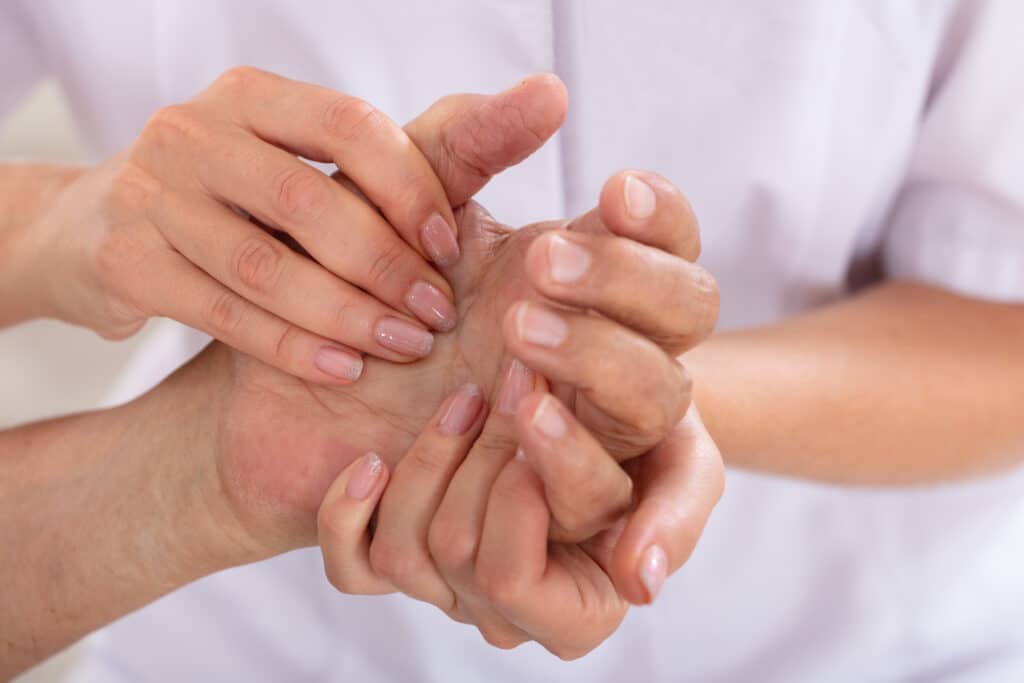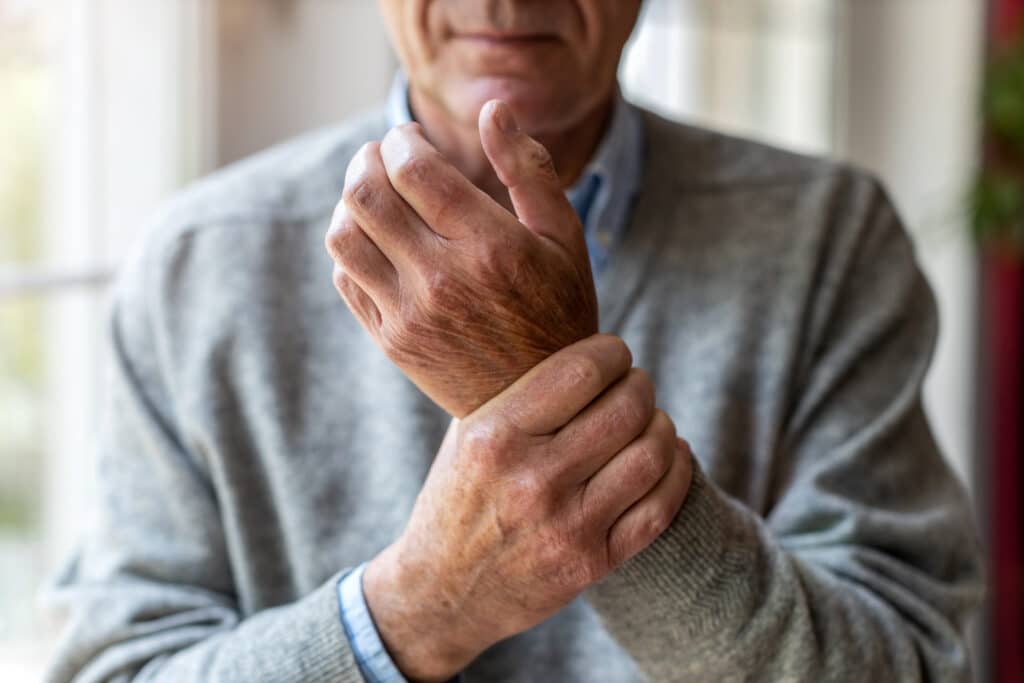Have you ever struggled with discomfort, stiffness, numbness, or a lack of strength in your hands or arms? You’re far from alone. Many seniors live with conditions that impair their hand and upper extremity function, but hand therapy can help.
It can be frustrating when your hands don’t perform as you’re used to. These conditions can restrict your ability to carry out daily tasks, partake in your favorite hobbies, or work as you’re used to.
Thankfully, hand therapy provides a solution that can help you reclaim your function, mitigate your discomfort, and boost your quality of life.
In this article, we will explore hand therapy, what conditions it can help to improve, the benefits it can provide, and how you can begin your own hand therapy treatment.
Whether you have a recent injury, a long-standing condition, or are on the road to recovery following surgery, hand therapy can help you accomplish your goals and enhance your quality of life.
What Does Hand Therapy Involve?

Hand therapy is a specialized form of rehabilitation delivered by a credentialed physical or occupational therapist trained to manage hand and upper extremity conditions. These certified hand therapists provide rehabilitative techniques customized for patients with conditions impacting the hands and arms.
A therapist’s chief aim is to enable patients to return to productive lifestyles by enhancing function, diminishing pain, and limiting further complications.
Hand therapy usually begins with an initial assessment to gauge the patient’s symptoms, goals, and needs. The therapist then presents a variety of treatments both during sessions and in the form of prescribed exercises to be performed at home. [1]
The muscles, tendons, and ligaments within this region of your body are so intricate that when specifically targeted with professional guidance, substantial improvements can be made. In my experience treating patients with hand, wrist, and finger injuries, it’s often remarkable how quickly progress can occur.
Hand therapy can be challenging, and it’s natural to become frustrated. Still, it’s crucial to persist with the prescribed treatment exercises—you’ll be astounded at the progress you can achieve!
Which Conditions Can Hand Therapy Alleviate?

Hand therapy is an incredibly valuable resource for several hand and upper extremity conditions. Whether you’re grappling with fractures, tendon repairs, arthritis, stiff hands or fingers, trigger fingers, tennis elbow, carpal tunnel syndrome, nerve injuries, amputations, or other related issues, hand therapy can offer significant benefits.
Hand therapy can tackle many conditions that otherwise result in discomfort, swelling, stiffness, numbness, weakness, or loss of function in the hand or arm.
Below are some of the common conditions that hand therapy can effectively stop in their tracks [2, 3]:
Fractures
Hand therapy plays a crucial role in rehabilitating fractures in the hand or wrist. It promotes proper healing, restoring the range of motion, and bolstering the affected area.
Hand therapists may utilize gentle mobilization exercises, splinting, and therapeutic exercises tailored to the specific fracture type.
Tendon Repairs
Hand therapy is integral for optimal recovery following tendon repairs in the hand or wrist.
Hand therapists collaborate closely with patients to restore tendon function, enhance strength, and improve dexterity through targeted exercises, splinting, and specialized techniques.
Arthritis
Hand therapy can assist individuals with arthritis in managing pain, reducing joint inflammation, and enhancing hand function.
Hand therapists may utilize exercises to enhance joint mobility, provide education on joint protection techniques, and recommend adaptive equipment to assist with daily activities.
Stiff Hands or Fingers
Conditions such as trigger finger, Dupuytren’s contracture, or joint stiffness can significantly affect hand mobility.
Therapy might include various techniques, including stretching exercises, joint mobilizations, and custom splinting, to boost flexibility, restore the range of motion, and alleviate stiffness.
Tennis Elbow
Therapy is pivotal in rehabilitating lateral epicondylitis, commonly known as tennis elbow.
Therapists use exercises and manual therapy techniques and provide education on activity modification to alleviate pain, improve grip strength, and promote healing.
Carpal Tunnel Syndrome
Hand therapy is an effective non-surgical treatment option for carpal tunnel syndrome.
Hand therapists can provide specific exercises to improve hand and wrist mobility, recommend splinting to relieve pressure on the median nerve, and educate patients on ergonomic modifications to prevent symptom recurrence.
Nerve Injuries
Hand therapy is instrumental in nerve injury rehabilitation, aiming to restore sensation, promote nerve regeneration, and enhance hand function.
Therapists use specialized techniques such as sensory re-education, desensitization exercises, and graded motor imagery to facilitate nerve recovery.
Amputations
In the aftermath of hand or finger amputations, hand therapy is crucial in aiding individuals to adapt and regain function. Therapists work closely with patients to develop prosthetic training programs, enhance strength and coordination, and support psychosocial adjustment.
These are only a few examples of the conditions that hand therapy can effectively manage. Hand therapists possess specialized knowledge and skills to create personalized treatment plans tailored to each patient’s needs, ensuring the best possible outcomes.
What Benefits Can Hand Therapy Provide?

The primary benefit of hand therapy is the opportunity to get back to doing the things you love, whether writing, gardening, or even driving your car without pain.
Hand therapy offers many benefits to patients who require rehabilitation for hand and upper extremity conditions. Consequently, therapists use different techniques to alleviate pain and discomfort associated with these conditions, including heat or cold therapy, ultrasound, or electrical stimulation. Manual techniques can help alleviate muscle tension and joint stiffness.
Potential Benefits of Hand Therapy
Restoring and enhancing the range of motion in the hand, wrist, and fingers is another crucial aspect of hand therapy. Therapists utilize targeted exercises, joint mobilizations, and stretching techniques to improve flexibility and joint function. They also employ strengthening exercises and activities to bolster muscle strength, endurance, and coordination.
Hand therapists work with patients to help them regain functional independence. They offer training on adaptive techniques, recommend assistive devices or splints, and educate patients on energy conservation strategies. They can also minimize scar tissue formation and improve scar mobility following hand surgeries or injuries.
For conditions that cause swelling and edema in the hand and upper extremities, therapists may use compression garments, wraps, retrograde massage, and elevation techniques. This will help reduce swelling and improve overall hand function.
Hand therapists also provide education about conditions, self-management strategies, ergonomic principles, and injury prevention techniques. This empowerment allows seniors to actively participate in rehabilitation, promoting improvements in pain and functional movement.
Emotionally, dealing with hand or upper extremity conditions can be challenging. In such cases, hand therapy can offer valuable psychosocial support, helping patients cope with their conditions’ physical and emotional aspects, thus promoting overall well-being and a positive outlook.
What Techniques Do Hand Therapists Use?

Hand therapy employs various techniques and approaches to cater to each patient’s needs. These include active and passive exercises to improve range of motion, strength, and hand and upper extremity coordination.
Therapists may also use heat and cold therapy, ultrasound, electrical stimulation, and paraffin wax baths to enhance treatment.
Hand therapists can design and fabricate custom-made splints to provide support, promote healing, and ensure proper alignment. Manual techniques such as joint mobilizations, soft tissue mobilization, and scar tissue massage can improve joint range of motion, reduce pain, and promote tissue healing.
A crucial aspect of hand therapy is educating patients about modifying their daily activities and ergonomics to minimize hand and upper extremities stress.
Above all, hand therapy is individualized to meet each patient’s unique needs and goals. Therapists work closely with patients to develop personalized treatment plans and provide ongoing support throughout rehabilitation.
How Can I Get Started with Hand Therapy?

Consult your healthcare provider if you feel you might benefit from hand therapy. They will help you look for a certified hand therapist (CHT) with specialized training in treating hand and upper extremity conditions specific to your needs.
Once you find the proper specialist, schedule an initial evaluation, and based on the findings, the therapist will develop an individualized treatment plan.
It’s essential to be consistent and follow the therapist’s recommendations carefully—a single session is not enough to treat most conditions. The best outcomes are seen in patients who adhere to the treatment frequency and duration as their therapist advises.
Key Takeaways
In wrapping up, let’s revisit the key points. Hand therapy is a tried and true method for easing discomfort and restoring strength in your hands and arms, helping you return to the activities you love. If this resonates with your situation, it’s worth chatting with your doctor and seeking a Certified Hand Therapist near you.
They’ll work closely with you to develop a plan tailored to your needs. Remember that hand therapy isn’t just for everyday aches and pains; it can significantly help with more specific conditions like carpal tunnel syndrome or even recovery from surgery.
Many insurance plans do cover hand therapy, making it accessible to most. So, as you embark on this journey towards improved hand health, remember the focus remains on you, your comfort, and enhancing your overall quality of life. And that’s a path worth taking.
FAQ
How does physical therapy differ from occupational therapy?
Physical therapy focuses on overall body movement and function. In contrast, occupational therapy helps individuals regain skills necessary for daily activities, especially those involving hands and upper extremities.
How can I verify if a therapist is certified in hand therapy?
Check if the therapist holds the Certified Hand Therapist (CHT) credential. This designation indicates that they have met rigorous standards and possess advanced knowledge in hand therapy.
Are there any hand therapy tools that I can use at home?
Yes, there are several tools available that can aid your rehabilitation journey. Your hand therapist can recommend specific tools based on your needs.
Can hand therapy help with conditions like carpal tunnel syndrome?
Yes, hand therapy can provide specific exercises, splinting, and other techniques to alleviate symptoms of carpal tunnel syndrome.
Does insurance cover hand therapy?
Most insurance plans cover hand therapy, but coverage varies. Generally, it’s best to check with your insurance provider to understand the specifics of your policy.
References
American Society for Surgery of the Hand. (n.d.). Hand therapy: What is right for me? Retrieved from https://www.assh.org/handcare/condition/hand-therapy
Harvard Health Publishing. (2018). Exercises for pain free hands. Retrieved from https://www.health.harvard.edu/pain/exercises-for-pain-free-hands
American Academy of Orthopaedic Surgeons. (2022). Therapeutic exercise program for carpal tunnel syndrome. Retrieved from https://orthoinfo.aaos.org/contentassets/3ceba801b19a40b2ad071b05f133c6a2/2022-therapeutic-exercise-program-for-carpal-tunnel.pdf
Stralka SW. Hand Therapy Treatment. Hand Clin. 2016 Feb;32(1):63-9. doi: 10.1016/j.hcl.2015.08.007. PMID: 26611390.
Cavaleri R, Schabrun SM, Te M, Chipchase LS. Hand therapy versus corticosteroid injections in the treatment of de Quervain’s disease: A systematic review and meta-analysis. J Hand Ther. 2016 Jan-Mar;29(1):3-11. doi: 10.1016/j.jht.2015.10.004. Epub 2015 Nov 6. PMID: 26705671






